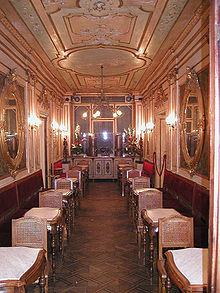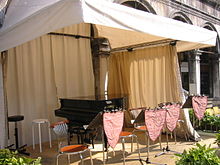Caffè Florian
The Caffè Florian is a famous Venetian coffee house on the Piazza San Marco . It was opened on December 29, 1720 under the arcades of the Procuratie Nuove and still retains much of the 19th century decor. It is Italy's oldest coffee house. Similar to the later coffee houses, the Florian served as a meeting place for artists and intellectuals, but today mainly for tourists.
history
Coffee became known in Venice through traders from the Ottoman Empire . Coffee has been sold since 1638, but it was viewed more as a medicinal product. In 1676 the Senate dealt with the public serving of the drink for the first time. In 1683, after coffee had previously only been sold in apoteche , a first coffee house was established under the New Procuraties , followed by two more in 1700 under the New and Old Procuraties. In London , where the development started a little earlier, there were already at least 2000 coffee houses around 1700, which were understood to be simple bars for the drink.
Café run by the Florian family (1720 to 1858)
On December 29, 1720 another foundation followed at the place of today's Florian. The owner of the restaurant was the cafeteria Floriano Francesconi. He initially called his Bottega del caffè Alla Venezia Trionfante . However, it became common practice to name the café only after the first name of the owner, so it was soon only called "Florian". It was still a simple bar with two oil lamps, but it was possible to get nobles to visit the house. The location was ideally suited for this, as numerous council bodies, including the Grand Council, met regularly in the nearby Doge's Palace, and authorities were in the procuraties. In addition, it was soon not the simple London coffee houses that were copied, but the very different Parisian cafes. Accordingly, additional food and alcoholic beverages were offered and women were admitted. In contrast to London, Venice cafes attracted less traders interested in commercial transactions and information exchange than did the city's political and philosophical elite. Therefore, the audience came from the politically leading nobility of the city.
Floriano Francesconi's nephew Valentino, who took over the coffee house after the death of his uncle in 1773, also officially departed from the original name. When the French occupied the city, he removed the still existing sign with the original name, probably because he feared difficulties with the new city lords in view of the presumptuousness it contained. In 1775 Giorgio Quadri di Corfù founded the Caffè Quadri on the other side of the square , which also still exists today. As the last of his family, Valentino's son Antonio took over the Florian from the late 1820s.
The Florian has, while the "Austrian" met in the first half of the 19th century to the meeting point of the Italian patriots in Quadri. In 1848 the Florian was one of the agitation centers against the Habsburg rule .
New owners, renovation, expansion (from 1858)
After the café was sold in 1858, the new owners Vincenzo Portù, Giovanni Pardelli and Pietro Boccanello undertook a complete and costly redesign of the place. The 'Senators' Room' received allegorical murals depicting ' Science and Progress', alongside a' Greek 'and a' Persian ' salon-like room, a Chinese and an Oriental room, and a Sala degli Uomini , which will be restored in 2012 has been. There he created portraits of Carlo Goldoni , Enrico Dandolo and Marco Polo , Pietro Orseolo , Francesco Morosini , Paolo Sarpi , Tizian , Andrea Palladio and Vettor Pisani . The Sala delle stagioni , also called Sala degli Specchi (Hall of Mirrors), showed four women as representatives of the seasons. As early as 1860 there was a room for women in which smoking was not allowed. The Sala Liberty was added at the beginning of the 20th century .
In 1893, Mayor Riccardo Selvatico developed the idea of an art exhibition with friends in the Florian, from which the Biennale emerged . In July 1943, after Mussolini had been overthrown, the resistance fighter Armando Gavagnin, standing on one of Florian's chairs, gave a fiery speech. Previously, he was carried on shoulders across St. Mark's Square. He managed to convince the fleet commander to release anti-fascist prisoners. Gavagnin became mayor of Venice in 1958.
This design and extension by two rooms, which the three new owners transferred to the architect Ludovico Cadorin from the Accademia di belle arti di Venezia , has largely been preserved to this day. From April to September, often also in October, there is a stage in front of the Florian, on which mainly pianists perform.
Famous visitors to the Florian included Goethe , Lord Byron , Honoré de Balzac , Giacomo Casanova and Marcel Proust, but also Richard Wagner , Thomas Mann , Hugo von Hofmannsthal , Jean Cocteau and Jorge Luis Borges .
Today the Florian belongs to the “Fendi” group, an important fashion dynasty.
literature
- Gianni Berengo Gardin: Caffè Florian , Marsilio, 2013.
- Danilo Reato: La bottega del caffè. I caffè veneziani tra '700 e' 900 , Fondazione scientifica Querini Stampalia, Venice 1991.
- William Dean Howell's “Life in Venice” Ruetten & Loening, Berlin, 1987
Web links
- Website of the restaurant
- gotha del gusto , film 4:19 min (gives interesting insights into the premises despite self-promotion) (ital.)
- short film for the 290th birthday , 1:59 min (Italian)
Remarks
- ↑ Memorie intorno a Luigi Ferdinando Marsili , Accademia delle scienze dell'Istituto di Bologna 1930, p. 378.
- ↑ Kelly Intile: The European Coffee House. A Political History , Thesis, University of Oregon, 2007, p. 14.
- ^ Giovanni Distefano, Franco Rocchetta: Atlante storico di Venezia , Supernova, 2008, p. 532; Nessia Laniado: Caffè , Urra, Milan 2007, p. 17.
- ↑ Kelly Intile: The European Coffee House. A Political History , Thesis, University of Oregon, 2007, p. 19.
- ↑ Klaus Thiele-Dohrmann: European coffee house culture , Artemis & Winkler, 1997, p. 26.
- ↑ Venezia, risplende il Caffè Florian restaurata sala degli Uomini Illustri. Specchi, fregi e cornici rinascono sotto le Procuratie Vecchie , in: Corriere del Veneto, October 8, 2012.
- ^ William Dean Howells: Life in Venice , Ruetten & Loening, Berlin, 1987, p. 39.
- ^ Richard JB Bosworth : Italian Venice. A History , Yale University Press, 2014, p. 170.
Coordinates: 45 ° 26 ′ 3.6 ″ N , 12 ° 20 ′ 16.8 ″ E





